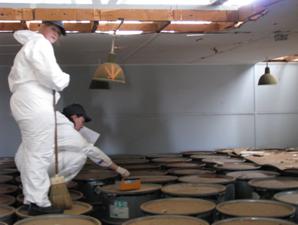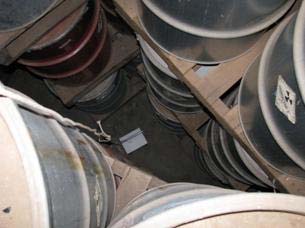
RELEASED
BY
ARPANSA
RADIOLOGICAL SURVEY REPORT -
CSIRO RADIATION WASTE STORE, WOOMERA, SOUTH
AUSTRALIA
UNDER
Rick Tinker
Tracy Wright
FOI
FEBRUARY
2019
Technical Report (Version 1)
619 Lower Plenty Road
October 2008
Yallambie Vic 3085
Telephone: +61 3 9433 2211
Fax: +61 3 9432 1835
Background
This report details the radiological assessment and inspection of the CSIRO Radiation Waste
Store at Woomera. It has been prepared by the Health Physics Section (HPS) at the request of
ARPANSA’s Regulatory and Policy Branch (RPB).
RELEASED
The store contains approximately 10,000 drums of soil and other solid material contaminated
with uranium ore processing residues. The origin and background of this material is supplied
in the Report “Environmental Audit of Evetts Field Waste Facility – January 2004, ARL File
H2-04-02”.
BY
Scope
ARPANSA
This assessment is based on a survey of gamma dose rates in and around the waste store and
radon in air measurements inside the store.
Site Description
UNDER
The waste store is an Annexe to Hangar 5 at Evetts Field, which is situated on Department of
Defence (DOD) land within the Woomera Prohibited Area. s 33 - security
FOI
FEBRUARY
Figure 1 shows a schematic of the Annexe. There is approximately 1 m of space inside the
entrance to the front of the stacked drums. The drums are stacked 3 high on crates, and take
up Bays 1, 2 and 3 and Store Room 1. Just inside the entrance there are a set of makeshift
stairs made from crates to access the top of the drums. These were not used for access;
2019
instead a ladder was tied to the drums. No access is available from the ground except at the
entrance. There are some drums stored in Store Room 2, and none in Store Room 3.
Radiological Investigation Methods
The inspection of 3 September 2008 was attended by Rick Tinker and Tracy Wright from the
HPS and Helen Topfer from the RPB of ARPANSA, along with Jeffrey Sheridan from
CSIRO Corporate Property Services. The DOD provided an escort during the inspection. A
RELEASED
range of photographs were taken during the inspection and are shown in the Appendix.
A survey of gamma dose rates was undertaken using an Exploranium GR-130 gamma ray
spectrometer (Serial Number 9986+GM, calibrated on 22/08/2008). A typical uncertainty of
measurement is 10% at 1 standard deviation. Where possible, measurements were repeated in
BY
locations where results have previously been obtained. Outside the Annexe, measurements
were taken at all doorways into the store (with doors closed) at the surface of the building.
ARPANSA
Inside the store, 3 measurements were taken at ground level (1 m above the ground) and 6
measurements were taken on top of the drums at the surface and 1 m above the surface of the
drums. The numbers of the measured drums were recorded. The locations of some of the
previously measured drums were marked with orange arrows on the beams or light fittings
UNDER
above and orange circles on the drum lids, however some could not be found. The dose rate
was also measured along the boundary wall from within the Annexe. A DOD representative
used the GR-130 to take measurements along the wall adjoining Hangar 5 from inside the
hangar.
FOI
The SARAD 1688-2 radon monitor (Serial Number 078/05/08, calibrated on 30/05/2008) was
FEBRUARY
used to take 15 minute samples inside the Annexe.
Radiological Survey Results
The results of the gamma dose rate survey are shown in Figure 1. Dose rates varied from 80 to
2019
550 nSv/h (surface measurement) at all entry points to the Annexe with doors closed. At door
5 where the dose rate is 550 nSv/h, the dose rate at 1 m is 320 nSv/h. This is in agreement
with the sign at the entrance which states that dose rates at 1 m do not exceed 0.5 μSv/h. The
dose rates along the wall adjoining Hangar 5 were measured from inside the hangar and
ranged from 25 to 45 nSv/h. The hangar dose rate levels are lower than the average gamma
dose rate found inside Australian homes of 100 nSv/h (Langroo et al, 1990).
Radiological Survey Report – CSIRO Radiation Waste Store, Woomera
Page No. 3
The drum dose rates ranged from 150 to 9100 nSv/h when measured on the drum surface. At
a distance of 1 m from the drum surface, the dose rates varied from 180 to 3000 nSv/h.
A comparison between dose rate measurements taken during this visit and measurements of
21 January 2004 is shown in Table 1. There is very little difference between the
RELEASED
measurements considering that there is a 10% uncertainty in the measurements taken during
this visit and that the exact positions of the detection equipment could not be replicated.
Table 1: Comparison between measurements taken during this visit and measurements
of January 2004.
BY
Dose rate - this visit
Dose rate - previous visit
ARPANSA
Measurement location
(nSv/h) *
(nSv/h)
Door 1, 1 m above ground at door surface
80
70
Entrance door (door 2), 1 m above ground at door surface
180
150
Door 3, 1 m above ground at door surface
180
200
Door 4, 1 m above ground at door surface
130
200
UNDER
Door 5, 1 m above ground at door surface
550
500
Door 6, 1 m above ground at door surface
300
200
Door 7, 1 m above ground at door surface
180
200
Door 8, 1 m above ground at door surface
100
-
Inside entrance, 1 m above ground
230
200
FOI
Inside store room 2, 1 m above ground
150
150
Inside store room 3, 1 m above ground
180
150
FEBRUARY
At drum 8242, 1 m above
200
300
At drum 8242, drum surface
150
-
At drum 2122, 1 m above
1350
1500
At drum 2122, drum surface
5000
-
At drum 9374, 1 m above
220
350
At drum 9374, drum surface
180
-
2019
At drum 3746, 1 m above
300
-
At drum 3746, drum surface
330
-
At drum 1791, 1 m above
3000
-
At drum 1791, drum surface
9100
-
At drum 6523, 1 m above
760
900
At drum 6523, drum surface
760
-
* Uncertainty 10% (1sd)
Radiological Survey Report – CSIRO Radiation Waste Store, Woomera
Page No. 4
80
Store
Store
Room
Room
3
2
25
180
150
s 33 - security
RELEASED
25
Store
DRUM 8242
Room
230
150 at Surface
1
180
200 at 1 m
BY
27
Bay 1
DRUM 2122
5000 at Surface
ARPANSA 1350 at 1 m
s 33 - security
DRUM 9374
180
180 at Surface
DRUM 3746
220 at 1 m
330 at Surface
45
300 at 1 m
UNDER
Bay 2
130
28
FOI
DRUM 1791
FEBRUARY
9100 at Surface
3000 at 1 m
29
550
(320 at 1 m)
DRUM 6523
100
760 at Surface
760 at 1 m
2019
Bay 3
300
180
Figure 1: Radiation Survey in the CSIRO Annexe Store, Woomera Rangehead. All dose
rate measurements in nSv/h.
Radiological Survey Report – CSIRO Radiation Waste Store, Woomera
Page No. 5
The results of the radon-222 survey are shown in Table 2. Results are an average
concentration of radon-222 levels measured over 15 minutes. Levels ranged from 24 to 94
Bq/m3. The highest radon level of 94 Bq/m3 was measured next to an ajar lid of drum 3613
indicating the possible leakage of radon-222.
RELEASED
The levels of radon-222 measured in the January 2004 study ranged from 8 to 60 Bq/m3.
These levels were measured over several years, and although similar, can not be directly
compared with the measurements taken during this visit.
Table 2: Results of radon survey inside Annexe.
BY
Measurement location
Radon concentration (Bq/m3)
ARPANSA
Inside entrance on floor close to drums
70 ± 41
Next to ajar lid of drum 3613
94 ± 47
On ground in gap between drums, near drum 2122
24 ± 24
On ground near drums in Store Room 2
70 ± 41
UNDER
Conclusion
The annual occupational limit is 20 mSv (APRANSA , RPS 1). Given a typical 2000 hour
FOI
working year an hourly limit of 10000 nSv can be derived. Comparison of the gamma dose
rates around the Annexe store are clearly well below this limit with a maximum of 550 nSv/h.
FEBRUARY
Inside the Annexe the gamma dose rate levels ranged from 150 to 9100 nSv/h. With no more
than 2 day inspections over a year, the annual occupational limit will not be exceed.
The low radon-222 levels measured during this visit indicate that ventilation within the
Annexe is adequate to maintain levels below the action levels in the workplace. The
2019
recommended action level for radon concentration in air in workplaces is set at 1000 Bq/m3
(APRANSA , RPS 1).
The gamma dose rates and radon-222 levels in Annexe are well below action limits and
present no radiation hazard.
Radiological Survey Report – CSIRO Radiation Waste Store, Woomera
Page No. 6
Limitations of this Report
This report has been prepared in accordance with the scope and services described, in
consultation with ARPANSA’s Regulation and Policy Branch (RPB). It may not contain
sufficient information for the purposes of other parties or other uses. To the best of our
RELEASED
knowledge the information contained in this report is accurate at the date of issue.
REFERENCES
Williams, G, A., Environmental Audit of Evetts Field Waste Facility – January 2004, ARL
BY
File H2-04-02”.
ARPANSA
Langroo, M. K., Wise K. N., Duggleby, J. C. and Kotler, L. H., “A nationwide survey of
Radon-222 and gamma radiation levels in Australian homes”, Health Physics (1991), 61,
753-761.
UNDER
ARPANSA, Radiation Protection Series No. 1 (RPS 1), Recommendations for Limiting
Exposure to Ionizing Radiation (Printed 1995 - Republished 2002) and National Standard for
Limiting Occupational Exposure to Ionizing Radiation (Printed 1995 - Republished 2002)
FOI
FEBRUARY
2019
Radiological Survey Report – CSIRO Radiation Waste Store, Woomera
Page No. 7


 Appendix – Photos from the inspection
Appendix – Photos from the inspection
RELEASED
BY (a) (b)
ARPANSA
Photo 1: (a) the condition of the ceiling has deteriorated, and (b) the ceiling material has fallen
onto the drums.
UNDER
FOI
FEBRUARY
2019
(a) (b)
Photo 2: (a) a drum is marked with an orange arrow above, and (b) the drum lid is marked
with an orange circle.
Radiological Survey Report – CSIRO Radiation Waste Store, Woomera
Page No. 8


RELEASED
BY
ARPANSA
Photo 3: The SARAD radon monitor was lowered into a gap in the drums to measure the
radon concentration at ground level.
UNDER
FOI
FEBRUARY
2019
Photo 4: A ladder just inside the entrance was used to access the top of the drums. The crate-
stairs are also shown.
Radiological Survey Report – CSIRO Radiation Waste Store, Woomera
Page No. 9
s 33 - security
RELEASED
BY ARPANSA
UNDER
FOI
FEBRUARY
2019
Radiological Survey Report – CSIRO Radiation Waste Store, Woomera
Page No. 10





